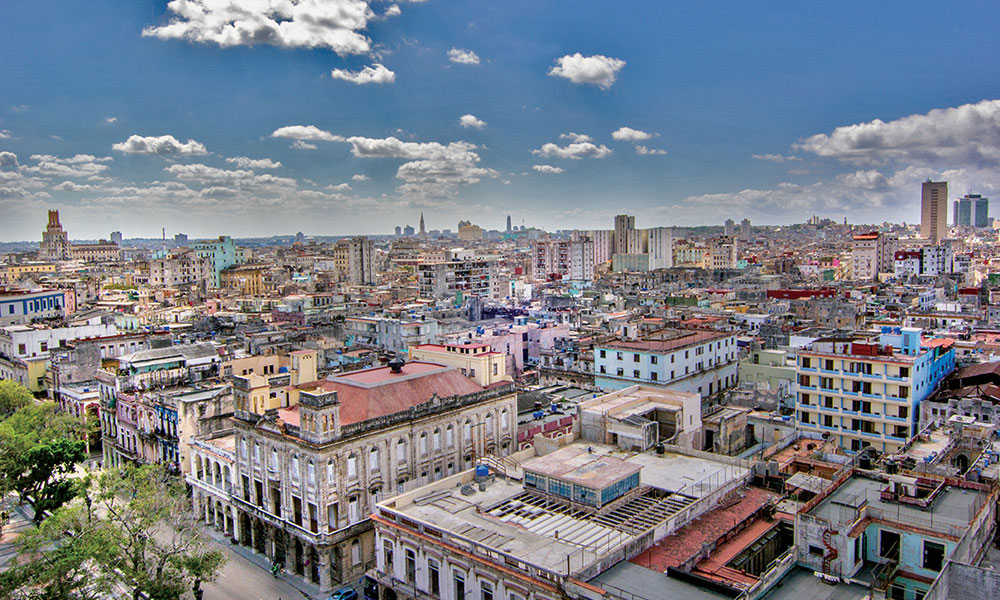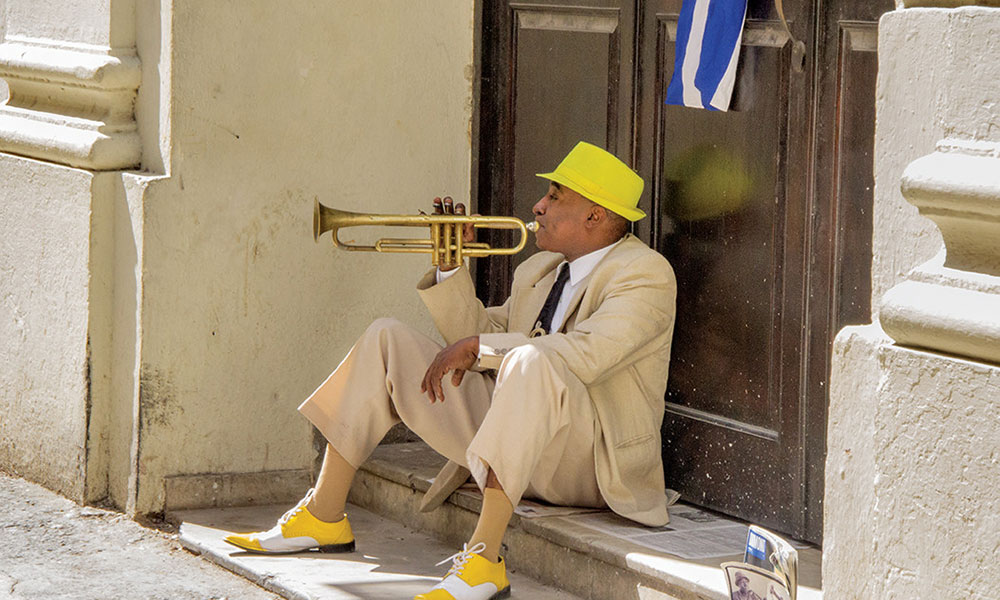Plastered across a roadside billboard in the Vedado district of Havana, two rows of young ballerinas smile with eyes upturned and arms outstretched. Next to the photo, bold text declares, “LA REVOLUCIÓN ES INVENCIBLE.”
This is one of the many patriotic displays that pepper Cuba’s aging thoroughfares. My four-hour cab ride from Havana to Trinidad could have been pitched as a scenic tour of the island’s government-sanctioned ideology; photos of Fidel Castro, stencils of Che Guevara, and billboards referencing La Revolución recurred ad nauseam, emerging from the horizon, swelling, and passing along the side of the highway like waves in a sea of propaganda.
“What do you think of those?” I asked my cab driver in Spanish, gesturing towards a particularly explicit banner up ahead. It was a cartoon of a disembodied forearm labeled “La Revolución” clenching its fist, poised to crush Uncle Sam against a brick wall labeled “Embargo.”
He shot me an unimpressed glance in the rearview mirror. “It’s like, blah blah blah,” he responded in English, with a flick of his fingers. This was before the police pulled him over for impersonating a taxi driver.

Most Cubans don’t actually exhibit the frenzied nationalism of their roadside propaganda. That said, many locals do offer Americans a glowing introduction to the island through people-to-people tours.
U.S. citizens can visit Cuba legally so long as they participate in a “people-to-people exchange,” a category of sanctioned travel that the U.S. Department of the Treasury defines as “a full-time schedule of educational exchange activities intended to enhance contact with the Cuban people, support civil society in Cuba, or promote the Cuban people’s independence from Cuban authorities, and that will result in meaningful interaction between the traveler and individuals in Cuba.” Because the Cuban government is interested in the economic boost promised by American tourism, Cuban travel companies now offer “people-to-people” travel packages that grant U.S. citizens legal legitimacy for what otherwise amounts to an all-inclusive vacation.
Before my ill-fated trip to Trinidad, I sampled the “Escape to Havana” package offered by Vemares, a people-to-people tour provider that arranged my lodging, meals, tours, and transfers. I didn’t fully appreciate the effortless travel that Vemares made possible until after the package was over; many logistical complications can emerge when navigating Cuba on your own. For example, at the tail end of a 200-mile trip, you may discover that your cab driver is not an actual cab driver.
Despite the fixed itinerary, people-to-people tours have plenty to offer the adventurous explorer. My wild ride began when my guide, Lisa, and driver, Ernesto, picked me up from the Jose Martí Airport in a lime green 1956 Chevy 210. After cranking down the windows in Havana’s February heat, Lisa delivered a crash course on Cuba, listing important facts every foreigner should know:
Don’t drink the tap water, as it is known to upset American systems. Cuba has two kinds of currencies, the Cuban convertible peso (CUC) and the weaker Cuban peso (CUP), and while officially 1 CUC equals 24 CUP equals $1 US, you’ll have trouble exchanging a buck for any more than .87 CUC. There is very limited Internet access on the island, but some hotels will let you hop on their WiFi for 1.50 CUC per hour. Cubans receive their government-subsidized food rations for oil, rice, ground beef, chicken, eggs and more in librettos; other goods can be purchased in Tiendas de Regulación de Divisa, or TRDs. Raul Castro began allowing privatization in some industries back in 2010; he legalized modest private businesses only last year. Cuba has two national beers, Bucanero and Cristal. Lisa prefers Cristal, she said, as we weaved between the big-boned Chevys and Chryslers and miniature Ladas and Yugos of the Soviet era.
It didn’t take long to realize that people-to-people tours provide more than a legal loophole for American vacationers; true to their mission, they facilitate meaningful interactions between travelers and Cuban locals. Thanks to Vemares, I can look back on my time in Havana as a series of illuminating conversations and a handful of familiar faces, not just an indulgent holiday in an unfamiliar place.

One memorable conversation took place over lunch on that first day, when Lisa and I were the sole patrons in a lavish dining room. Lisa had described the place as an upscale “private restaurant,” but she had meant that the business was privately owned. I asked her why we were the only ones there.
“The average Cuban only makes 20 CUC [$20] per month,” she said. “You have to plan your spending very carefully.”
She explained that many of the private restaurants that have opened in Cuba over the past year are meant to cater to tourists, not locals. In a way, Cuba has two economies to go along with its two currencies. One caters to foreigners and mirrors their prices. The other corresponds to the Cuban way of life. For example, drivers with classic cars will over-charge tourists around 15 CUC to drive three or four miles in Havana. Cuban locals catch 60-cent rides in designated trucks, where rows of seats are lined up on either side of tall, ceilinged truck beds. And while locals may be shielded from homelessness, sickness, and starvation by government subsidies, they are still often forced to face the impossible prices of the outside world; despite the average monthly wage, a gallon of gas in Cuba still costs around 3.70 CUC.
After a few mojitos and a large dish of ropa vieja, our conversation turned to college tuition. In Cuba, education on all levels is 100 percent subsidized by the government. When I told Lisa about tuition rates in the United States, she was so shocked that I couldn’t help but laugh at my own country’s expense.
“You’re laughing,” she said, in disbelief. Then she smiled. “In Cuba, we also laugh at the bad things in our country.”
Along with Lisa, I owe many fond memories of Havana to the couple who hosted me at my casa particular. Every morning, Yolanda, an editor for a government-run magazine, and her husband, an engineering consultant, would chat with me over an enormous breakfast: omelets, ham, cheese, fresh bread, fruit, mango juice, guava juice, and strong Cuban coffee. They were well-versed in the history of U.S.-Cuba relations and had much to say about the Spanish-American War, Donald Trump, and the time Madonna danced on a dinner table in a fancy Cuban restaurant (it was her 58th birthday).
Not long after my arrival, I asked Yolanda and her husband about the famous Fábrica de Arte Cubano (FAC), an oil-refinery-turned-art venue where patrons can dine, drink, and dance among art galleries, fashion shows, live music and more. It turned out they were regulars at the FAC and had even been offered a VIP card by the prominent local artist Enrique Rottenberg, an Israeli photographer, director, and writer who exhibits his photography at the FAC when he’s not moonlighting as one of the most successful real estate tycoons on the island. They were kind enough to lend me their card.
On my first night at the FAC, I flashed the VIP card to skip a line that wrapped around the block, bought a 10 CUC mojito that was served in a glass just under the size of a pitcher, admired a two-story photography exhibit that surrounded a dance floor, and then stumbled into a death metal concert. On my second night, I had the pleasure of meeting the mysterious and eccentric Enrique Rottenberg himself, and we meandered through his exhibit together.
His work manages to be at once absurd and poignant. He casts his lens toward a number of serious topics ranging from the subconscious to the effect of capitalism on contemporary Cuban culture, only to destabilize the authority of his own perspective with his unique and unnerving sense of humor. One piece displays him at the edge of a barren landscape, frowning from his upright position in a baby-sized wash basin, his 50-something frame fully exposed. In another, he stands between two cock-eyed men wearing what appears to be a full-body cat costume. All three face the camera from a shabby room laden with water damage, and all three hold brightly colored boxes of Trix cereal. Rottenberg gestured toward a piece in which only his head was exposed at the top of a pile of raw chicken. Upon further inspection, the pile of chicken was actually part of some kind of sleeveless, full-body garment.
“Cuban Lady Gaga,” he told me, raising his eyebrows. He was certainly eccentric.
Having discovered the FAC, I fell into a happy rhythm. I spent my mornings and afternoons with Lisa, strolling through Old Havana to admire its bright, busy streets and Colonial Spanish architecture; staring up at the enormous likenesses of Che Guevara and Camilo Cienfuegos at La Plaza de la Revolución; walking along the edge of El Morro, the 16th-century fort where Habaneros protected their homes from raiding pirates; tip-toeing around animal bones left over from Santeria ceremonies held in Havana’s forests… I spent my free evenings back at the FAC, where I met locals, artists, and fellow travelers.
On my final night of the package, Lisa and I attended the Cabaret Parisien at the Hotel Nacional de Cuba, a popular hotel and tourist destination known for hosting the Sicilian and American Mafia’s Havana Conference in 1946. After an evening of drinks, chorus lines and feathered costumes, I was sorry to see our time together come to an end. We jotted down each other’s contact information before she dropped me off at my casa particular, where I would catch a few hours of sleep before heading off to Trinidad.
As for the fake cab driver: After failing to convince the police that he and I were lifelong friends on a road trip to Trinidad (he couldn’t remember my name), he was fined 50 CUC, well over two months’ wages for most Cubans. Despite the steep penalty, he remained in high spirits for the rest of our journey. He had charged me 75 CUC for the ride.
Note: President Trump announced new sanctions in June that limit individual people-to-people travel, but allow group people-to-people travel. To learn more, click here. For information about Vemares and the artist Enrique Rottenberg, click here.



